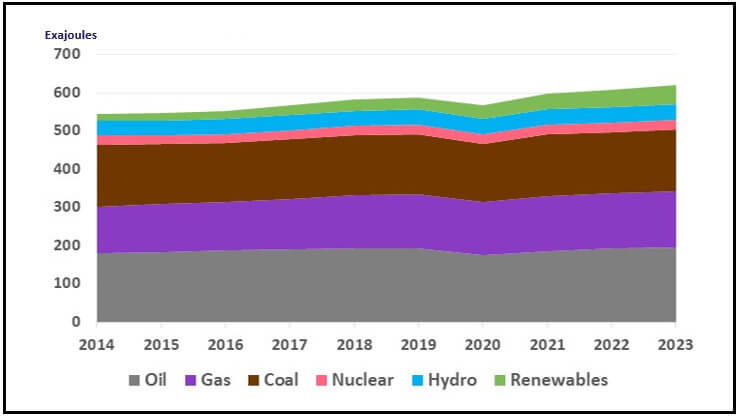UPDATED 1 Sept: The EI library in London is temporarily closed to the public, as a precautionary measure in light of the ongoing COVID-19 situation. The Knowledge Service will still be answering email queries via email , or via live chats during working hours (09:15-17:00 GMT). Our e-library is always open for members here: eLibrary , for full-text access to over 200 e-books and millions of articles. Thank you for your patience.
New Energy World™
New Energy World™ embraces the whole energy industry as it connects and converges to address the decarbonisation challenge. It covers progress being made across the industry, from the dynamics under way to reduce emissions in oil and gas, through improvements to the efficiency of energy conversion and use, to cutting-edge initiatives in renewable and low-carbon technologies.
New Energy Institute data highlights year of global records
20/6/2024
News
The Energy Institute has today published the Statistical Review of World Energy, providing the first complete set of data on energy production, consumption and emissions for all energy types around the world for the calendar year 2023. The Review is available as a free downloadable report and dataset.
The report finds that global primary energy consumption rose 2% to 620 Exajoules (EJ). Emissions from energy increased by a comparable amount and exceeded 40 GtCO2 for the first time. Since 2000, emissions from energy have grown by 50%.
Global fossil fuel consumption in 2023 increased almost as much as primary energy – 1.5%, to 505 EJ, although the share of fossil fuels in the primary energy mix was down marginally to 81.5%, from 82% in 2022.
Electricity generation from renewables (excluding hydro) increased by 13% to 4,748 TWh, driven almost entirely by wind and solar and accounting for 74% of all net additional electricity generated.

Global primary energy consumption by fuel type – global fossil fuel consumption in 2023 increased almost as much as primary energy, 1.5% to 505 EJ, although the share of fossil fuels in the primary energy mix was down marginally to 81.5%
Source: Energy Institute Statistical Review of World Energy
The general picture masks large regional differences. In Europe, the fossil fuel share of primary energy consumption fell below 70% for the first time since the industrial revolution. In the US, too, where the Inflation Reduction Act was passed in 2023, promising some $370bn of spending on measures on the energy transition and energy security, fossil fuels similarly fell to just over 80% of power generation.
However, in India, fossil fuels continue to grow; its consumption was up 8%. For the first time, more coal was used in India than Europe and North America combined. In that country, 96% of the power additions in 2023 there were fossil-fuel related.
Although China has experienced a big rebound in fossil-fuels overall (up 6%), just over half of its additions in power generation came from renewables, a trend which, if it continues, could see 150% of net power growth from renewables by 2030.
At a press conference to launch the statistics, Energy Institute President Juliet Davenport OBE HonFEI said: ‘The stop-start approach, particularly in the US and Europe, in deployment of renewables, does suggest that potentially we need to be thinking about how to depoliticise some of these investments to make sure that you can gain momentum.’
Energy Institute Chief Executive Officer Nick Wayth CEng FEI added: ‘The picture is lopsided for sure. But the danger of accepting this polarised, multi-speed trend as inevitable is that it doesn’t match up to the urgency of what the climate science is telling us.’
Co-authors of the Energy Institute Statistical Review of World Energy include KPMG and Kearney; data compilation was carried out by Heriot-Watt University; additional support came from BP and S&P Global Commodities.
Simon Virley CB FEI, Vice Chair and Head of Energy and Natural Resources, KPMG in the UK, said: ‘Next year will be 30 years since the first COP in Berlin in 1995. Back then, the share of world energy demand coming from fossil fuels was 86%, and as you have highlighted, we’ve got it down through all of these efforts of the last 30 years to 81.5%. If there’s one figure that really sums up where we are in the transition, it’s that. We’re going too slowly to be on track for our Paris Agreement goals.’
Romain Debarre FEI, Partner and Managing Director Energy Transition Institute, Kearney continued: ‘COP28 and rhetoric from world leaders on the energy transition demonstrates the ambition to reduce the world’s fossil fuel dependency. However, this ambition is futile unless it is matched with drastic and coordinated actions resulting in real and immediate impact on climate change mitigation.’
This year marks the second time the report has been published by the Energy Institute, after taking on the project from BP in 2023. New data series this year track battery storage and cells, carbon capture, hydrogen, ammonia and key minerals.
Watch the recording of the launch event
